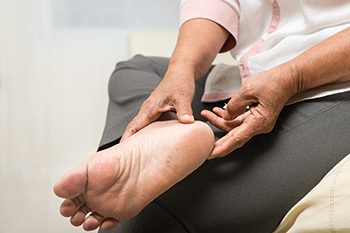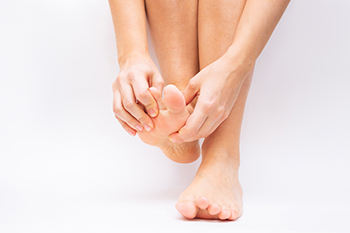

A bunion, or hallux valgus, is a common foot ailment where a bony bump occurs on the joint of a big toe when bones on the top part of the foot move out of place. The pressure causes the tip of the big toe to be pulled toward the smaller toes and forces the joint to remain stuck. Bunions can develop from wearing tight or narrow shoes or having an abnormal foot shape, a pre-existing medical condition (like arthritis), or a foot deformity. Bunionettes, or smaller bunions, might form on the joint of a smaller toe. Elderly people and women are more apt to get bunions. They can occur on one or both feet. Bunions can be painful, the joint might get stiff and swollen, and the skin may get sore and red. Prolonged standing might exacerbate the pain of a bunion. If left untreated, bunions can get worse over time, and it might become difficult to walk. Bunion pads, well-fitted shoes, or toe spacers might help. In severe cases, bunion surgery – a bunionectomy – might be called for. If you have a bunion, it is suggested that you see a podiatrist who can recommend the appropriate treatment for you.
If you are suffering from bunion pain, contact Dr. Thomas Tran of Southwestern Foot & Ankle Associates, P.C.. Our doctor can provide the care you need to keep you pain-free and on your feet.
What Is a Bunion?
Bunions are painful bony bumps that usually develop on the inside of the foot at the joint of the big toe. As the deformity increases over time, it may become painful to walk and wear shoes. Women are more likely to exacerbate existing bunions since they often wear tight, narrow shoes that shift their toes together. Bunion pain can be relieved by wearing wider shoes with enough room for the toes.
Causes
Symptoms
In order to diagnose your bunion, your podiatrist may ask about your medical history, symptoms, and general health. Your doctor might also order an x-ray to take a closer look at your feet. Nonsurgical treatment options include orthotics, padding, icing, changes in footwear, and medication. If nonsurgical treatments don’t alleviate your bunion pain, surgery may be necessary.
If you have any questions, please feel free to contact our office located in Frisco, TX . We offer the newest diagnostic and treatment technologies for all your foot care needs.

As the aging process occurs, the feet need special care and time to maintain overall foot health as this can positively affect the rest of the body. Many people enjoy soaking their feet in warm water due to its soothing effect. After the feet are thoroughly dried, many patients prefer to apply a good moisturizer on them and may choose to sleep with cotton socks on their feet. Additionally, it is beneficial to keep the toenails properly trimmed as this may help to avoid painful ingrown toenails from developing. The feet will feel good when the shoes that are worn fit correctly, and it is important to have the feet measured when new shoes are purchased. Any sores, blisters, cuts, or wounds that have developed on the feet may need immediate attention to ensure proper foot care is received. The feet will feel better when they are frequently stretched, and this can also help to strengthen the feet to prevent falling. If you would like more information about the type of care that elderly feet may need, please consult with a podiatrist who can address any concerns you may have.
Proper foot care is something many older adults forget to consider. If you have any concerns about your feet and ankles, contact Dr. Thomas Tran from Southwestern Foot & Ankle Associates, P.C.. Our doctor can provide the care you need to keep you pain-free and on your feet.
The Elderly and Their Feet
As we age we start to notice many changes in our body, but the elder population may not notice them right away. Medical conditions may prevent the elderly to take notice of their foot health right away. Poor vision is a lead contributor to not taking action for the elderly.
Common Conditions
Susceptible Infections
Diabetes and poor circulation can cause general loss of sensitivity over the years, turning a simple cut into a serious issue.
If you have any questions please feel free to contact our office located in Frisco, TX . We offer the newest diagnostic and treatment technologies for all your foot and ankle needs.

Research has shown that one third of women who frequently wear high heels have fallen while wearing them. High heels may be the cause of foot problems in women, and some may suffer permanent damage. The foot condition that is called hammertoe may develop, and this may happen when the toes do not have adequate room to move freely in. Additionally, many women can get ingrown toenails, which can occur when the toe rubs against the top of the shoe. The foot can be forced into an unnatural shape when the heels are two inches or higher, and this may alter the foot structure. The foot may slide forward, causing the weight of the body to redistribute, and the body may tilt forward. This can wreak havoc on the overall body, and the posture may be negatively affected. There are many women who enjoy wearing high heels, and there are shoes that can be worn that are safer on the feet and body. These can include choosing shoes that have a lower heel, wearing soft insoles inside the shoe, and alternating shoes worn from one day to the next. If you would like additional information about how high heels can affect the feet, please consult with a podiatrist who can answer any questions you may have.
High heels have a history of causing foot and ankle problems. If you have any concerns about your feet or ankles, contact Dr. Thomas Tran from Southwestern Foot & Ankle Associates, P.C.. Our doctor can provide the care you need to keep you pain-free and on your feet.
Effects of High Heels on the Feet
High heels are popular shoes among women because of their many styles and societal appeal. Despite this, high heels can still cause many health problems if worn too frequently.
Which Parts of My Body Will Be Affected by High Heels?
What Kinds of Foot Problems Can Develop from Wearing High Heels?
How Can I Still Wear High Heels and Maintain Foot Health?
If you want to wear high heeled shoes, make sure that you are not wearing them every day, as this will help prevent long term physical problems. Try wearing thicker heels as opposed to stilettos to distribute weight more evenly across the feet. Always make sure you are wearing the proper shoes for the right occasion, such as sneakers for exercising. If you walk to work, try carrying your heels with you and changing into them once you arrive at work. Adding inserts to your heels can help cushion your feet and absorb shock. Full foot inserts or metatarsal pads are available.
If you have any questions please feel free to contact our office located in Frisco, TX . We offer the newest diagnostic and treatment technologies for all your foot and ankle needs.

Individuals may experience pain in the toes for a multitude of different reasons. For example, toe pain may arise from problems in the bones or calluses that formed on the outside of the toes. One condition that can cause toe pain is known as lesions. These can develop on more than one toe, and sometimes on both feet. Lesions can cause pain during the day and create an extremely uncomfortable itching sensation throughout the night. Another important sign of lesions on the toes is swelling around the affected area and discoloration, which can essentially turn the toe into a purple tint. What can make toe lesions all the more troubling and uncomfortable is that wearing anything on the feet, from socks to shoes, can be extremely painful. Chilblains, a related condition, usually develop on the feet when blood vessels become inflamed as a result of exposure to cold temperatures. Some cases of toe lesions have also been identified in individuals who have tested positive for COVID-19, although any kind of definitive, causal relationship between the two conditions remains to be seen. If you think that you are suffering from toe lesions, consider reaching out to a podiatrist.
Toe pain can disrupt your daily activities. If you have any concerns, contact Dr. Thomas Tran of Southwestern Foot & Ankle Associates, P.C.. Our doctor can provide the care you need to keep you pain-free and on your feet.
What Causes Toe Pain?
Most severe toe pain is caused due to a sports injury, trauma from dropping something heavy on the toe, or bumping into something rigid. Other problems can develop over time for various reasons.
Toe pain can be caused by one or more ailments. The most common include:
When to See a Podiatrist
Diagnosis
In many cases the cause of toe pain is obvious, but in others, a podiatrist may want to use more advanced methods to determine the problem. These can range from simple visual inspections and sensation tests to X-rays and MRI scans. Prior medical history, family medical history, and any recent physical traumatic events will all be taken into consideration for a proper diagnosis.
Treatment
Treatments for toe pain and injuries vary and may include shoe inserts, padding, taping, medicines, injections, and in some cases, surgery. If you believe that you have broken a toe, please see a podiatrist as soon as possible.
If you have any questions please feel free to contact our office located in Frisco, TX . We offer the newest diagnostic tools and technology to treat your foot and ankle needs.

There is a strong band of ligament, known as the plantar fascia, on the bottom of the feet. It attaches to the heel bone and stretches forward, fanning out and dividing into 5 digital bands which connect with the base of the toes. The plantar fascia is integral to the foot’s biomechanics, helping to form and support the arch and absorb shock. Because the plantar fascia is constantly being stretched while walking, running, jumping, standing, dancing, etc., it can become damaged from overuse. This damage can include micro-tears in the tissue, causing inflammation and pain. This is known as plantar fasciitis. Long distance runners, people who are obese, or who have a tight Achilles tendon are more prone to developing plantar fasciitis. People who wear shoes or sneakers with insufficient arch support are also more prone to developing this condition. If you have pain in your heel that seems to be at its worst first thing in the morning, have your feet examined by a podiatrist.
Plantar fasciitis is a common foot condition that is often caused by a strain injury. If you are experiencing heel pain or symptoms of plantar fasciitis, contact Dr. Thomas Tran from Southwestern Foot & Ankle Associates, P.C.. Our doctor can provide the care you need to keep you pain-free and on your feet.
What Is Plantar Fasciitis?
Plantar fasciitis is one of the most common causes of heel pain. The plantar fascia is a ligament that connects your heel to the front of your foot. When this ligament becomes inflamed, plantar fasciitis is the result. If you have plantar fasciitis you will have a stabbing pain that usually occurs with your first steps in the morning. As the day progresses and you walk around more, this pain will start to disappear, but it will return after long periods of standing or sitting.
What Causes Plantar Fasciitis?
There are some risk factors that may make you more likely to develop plantar fasciitis compared to others. The condition most commonly affects adults between the ages of 40 and 60. It also tends to affect people who are obese because the extra pounds result in extra stress being placed on the plantar fascia.
Prevention
There are a variety of treatment options available for plantar fasciitis along with the pain that accompanies it. Additionally, physical therapy is a very important component in the treatment process. It is important that you meet with your podiatrist to determine which treatment option is best for you.
If you have any questions, please feel free to contact our office located in Frisco, TX . We offer the newest diagnostic and treatment technologies for all your foot care needs.
Copyright © Southwestern Foot and Ankle Associates, P.C. | Site Map | Nondiscimination | Design by: Podiatry Content Connection